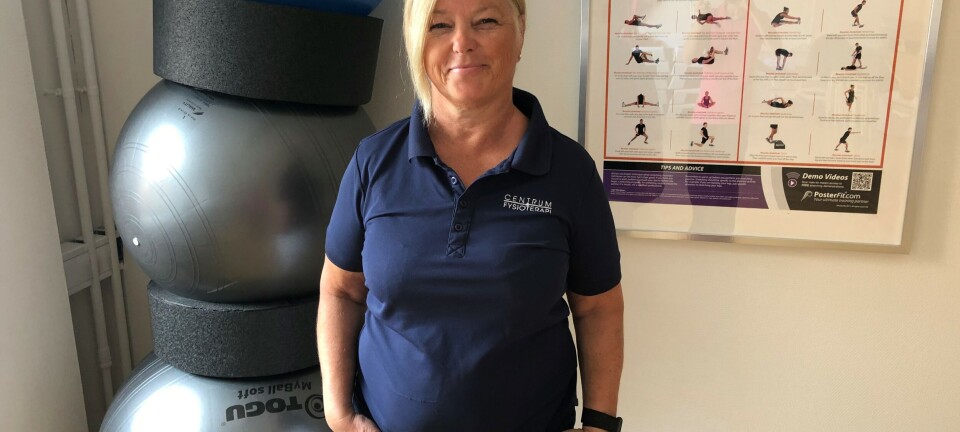Pain response classification does not predict long-term outcome in patients with low back pain who are sick-listed
Vitenskapelig artikkel i Fysioterapeuten nr. 5/2012
Pdf av artikkelen
Sources of financial support: The study is part of a randomized clinical trial financed by the municipalities of Silkeborg, Favrskov and Skanderborg, Denmark and the Central Denmark Region. This present part of the study was also supported by a grant from the Research Foundation of Danish Physiotherapists.
Ethical approval: The study was discussed with the regional research ethics committee. The study did not fall within the scope of the work of the committee and therefore formal ethical approval was not required. All participants signed informed consent, and the study was approved by the Danish Data Protection Agency (No. 2007-41-1278).
Conflicts of interest: None known.
n
Reprinted with permission of JOSPT and the Orthopaedic and Sports Physical Therapy Sections of the American Physical Therapy Association. Christiansen D, Larsen K, Jensen OK, Nielsen CV. Pain Response Classification Does Not Predict Long-Term Outcome in Patients With Low Back Pain Who are Sick-Listed. J Orthop Sports Phys Ther 2010;40(10):606-615. doi:10.2519/jospt.2010.3388.
Abstract
Study Design: Prospective cohort study nested in a randomized clinical trial.
Objective: To investigate the prognostic value of pain response classification at initial physiotherapy examination in patients with low back pain (LBP) who are sick-listed.
Background: Recurrent and chronic LBP accounts for a substantial proportion of all absence from work. In predicting outcome in patients with LBP psychosocial factors are thought to play an important role, while findings from clinical examination seem to be of more limited value. Mechanical evaluation using repeated end-range spinal movements resulting in specific pain responses have been shown to be of some value.
Methods: The study included 351 patients sick-listed because of LBP with or without sciatica. Prior to clinical examination, the patients completed a comprehensive questionnaire including questions on pain, function, and psychosocial factors. The physiotherapy examination included a standardized mechanical evaluation. Patients were classified into 3 groups according to their pain response: centralization, peripheralization, or no response. Outcomes were obtained by national register data, medical records, and a postal questionnaire at 1 year.
Results: At 1 year follow-up 65% of the patients had returned to work. All pain response groups showed significant and clinically important improvements in both pain and disability. No significant differences were found between pain response groups in any outcome measure. Result remained unchanged after adjustment for potential confounders.
Conclusion: The prognostic value of pain response classification seems limited in patients sick-listed from work because of LBP.
Keywords: Centralization, low back pain, prognosis, return to work, sick-listing.
Level of evidence: Prognosis, level 1b.
Reprinted with permission of JOSPT and the Orthopaedic and Sports Physical Therapy Sections of the American Physical Therapy Association. Christiansen D, Larsen K, Jensen OK, Nielsen CV. Pain Response Classification Does Not Predict Long-Term Outcome in Patients With Low Back Pain Who are Sick-Listed. J Orthop Sports Phys Ther 2010;40(10):606-615. doi:10.2519/jospt.2010.3388.
Background
Low back pain (LBP) is a common disorder and one of the most frequent reasons for seeking healthcare (33). Most LBP episodes are self-limiting, but a small percentage of people with LBP develop recurrent or chronic pain and disability (31). Recurrent and chronic LBP accounts for a substantial proportion of all absence from work (5). The longer the sick-listing, the more difficult is it to make a successful return to the labor market (33). Identifying predictors of persistent disability and developing tools for early intervention are, accordingly, considered important to rehabilitation and continued contribution to the work force (32). Although much research has been performed, only few prognostic factors have been consistently identified across studies (9).
Psychosocial factors are thought to play an important role. They include fear avoidance beliefs, pain behavior, somatization, and distress/depressive mood, and have shown to be associated with poor outcome in patients with LBP (16,25). The presence of compensation claims has consistently been reported to be a negative predictor of outcome (9). The findings obtained by clinical examination seem to be of limited value in predicting prognosis. Frequently used clinical tests include range of motion, palpation, and straight leg raise; but they provide no or little prognostic information in LBP patients (4,33), although the presence of sciatica does seem to have some predictive value (9).
Mechanical evaluation using repeated end-range spinal movements that produce specific pain responses (i.e. centralization (CEN) and non-centralization (non-CEN)) seems to hold some prognostic information for patients with LBP (1). This method is referred to as Mechanical Diagnosis and Therapy (MDT) (23). The CEN pain response is described as a process whereby pain radiating from the spine is sequentially abolished from the most distal position towards the lumbar midline, in response to repeated end-range therapeutic positions or movements. The non-CEN pain response is defined as either peripheralization (PER), a distal spread of pain into the limb or no response (NR), i.e. if no proximal change in pain location occurs. This mechanical evaluation may serve to categorize patients according to their mechanical syndromes. Thus, it has been suggested that patients with a CEN response and/or a reduction in symptoms as response to the mechanical loading strategies (directional preference) may be treated more effectively if treated with specific exercises matched to their directional preference (18,23). The prognostic significance of the CEN pain response has been evaluated in several studies (1). Thus, a CEN pain response has consistently been associated with good outcome in patients with acute and chronic LBP (8,13,20,28,29,35-38), reflecting a poorer prognosis when CEN is absent (1). However, only few studies have explored the prognostic value of pain response classification in the long-term in populations who are at increased risk of permanent disability (20,27,28). The objective of this study was to investigate the prognostic value of pain response classification at initial physiotherapy examination in patients with LBP who were sick-listed.
Methods
Subjects
The present study was conducted as a prospective cohort study nested in a randomized clinical trial. The sample consisted of 351 patients referred from their general practitioner to the Research Unit at the Spine Centre, the Regional Hospital of Silkeborg in Denmark from November 2004 to July 2007 (Figure 1). The patients were participants in a randomized clinical trial that explored the effect of brief clinical intervention versus a multidisciplinary intervention. Study details will be published elsewhere (12). Inclusion criteria: Partly or fully sick-listed for 4-12 weeks from work because of LBP with or without sciatica, age 16-60 years, and living in the municipality of Silkeborg, Favrskov, Skanderborg, or Randers in Denmark. Exclusion criteria: registered as unemployed, serious spinal pathology, progressive neural compression implicating plan of surgery, suspected progressive paresis or cauda equina syndrome, low back surgery the preceding year or previous lumbar fusion, pregnancy, dependency on drugs or alcohol, primary psychiatric disease, or not able to speak and understand Danish. Another 7 patients were excluded after inclusion, and 13 patients were excluded based on the physiotherapy examination (Figure 1). This left 331 patients for the present study. The study was discussed with the regional research ethics committee. The study did not fall within the scope of the work of the committee and therefore formal ethical approval was not required. All participants signed informed consent, and the study was approved by the Danish Data Protection Agency (No. 2007-41-1278).
Procedures
Before the clinical examination, the patients completed a comprehensive questionnaire including questions on pain, function, and psychosocial factors. The following variables were included: back and leg pain was measured by the Low Back Pain Rating Scale (LBPRS) (21). The LBPRS assesses the dimensions of pain, disability, and physical impairment for patients with LBP; only the pain index measure was used in this study. The pain index measure uses three 11-box (0-10) numeric rating scales, corresponding to pain now and worst and average pain during the previous 2 weeks, for back and leg pain separately. Each response score is added, giving a scale range of 0-60 points. LBPRS has been shown to be valid and reliable in the assessment of LBP (21). Disability was measured with the Roland-Morris Disability Questionnaire (RDQ), which has been cross-culturally validated in Danish (2). The RDQ score is calculated by adding the number of positive answers into a sum score, which ranged from 0 (no disability) to 23 (maximum disability). The RDQ is widely used internationally and has been shown to be a valid and reliable tool in the assessment of functional level patients with LBP (26). The duration of LBP was dichotomized into less and more than 3 months. Signs and symptoms of psychological disorders were assessed by a modified version of the validated Common Mental Disorders Questionnaire (CMDQ) (6). The questionnaire comprised 31 questions rated on a 5 point (0-4) scale of distress ranging from «not at all» to «extreme». Each item was then dichotomized between 1 «a little» and 2 «moderate» and added into sum scores in 4 different sub-scales (6). Two subscales assessed symptoms and signs commonly associated with somatoform disorders: bodily distress (SCL-SOM) and illness worries (Whiteley-7). One subscale included symptoms of general mental distress (SCL-8), and another subscale covered depressive symptoms (SCL-DEP6). The SCL-SOM subscale has only 1 question regarding LBP which was omitted. Fear avoidance beliefs were assessed by questions from the Orebro Musculoskeletal Pain Screening Questionnaire, which has previously been validated (17). Three questions on fear of physical leisure and work activities, each with a 0-10-score box scale, were added to a sum score (0-30). Questions about a possible filed compensation claim upon inclusion were registered as yes or now.
All patients underwent a clinical interview and low back examination which was performed by a physician specialist in rheumatology and rehabilitation (OKJ). The back examination comprised evaluation of posture, curvature of the spine, range of motion, neurological function (i.e. muscle strength test, sensory function, and deep-tendon reflex testing), Lasegue and femoral stretch test, spring test, tenderness with percussion, and standardized manual examination of tenderness of muscles. Nerve root pain was defined as symptoms or signs of nerve root compression/irritation, e.g. radicular pain in 1 or both lower extremities, positive Lasegue at 60º or less, missing or diminished reflex, motor weakness, or altered sensation in a dermatome. Relevant imaging and other examinations were ordered.
After the clinical examination, a physiotherapy examination was performed. A total of 95% of the examinations were performed by 1 therapist (DC) who holds a credentialed in MDT. The last 5% of the examinations were performed by a physiotherapist who holds a diploma in MDT (OM). The therapists were unaware of baseline questionnaire scores. The physiotherapy examination included a standardized mechanical evaluation according to the MDT assessment method (23). Briefly, a series of repeated end-range spinal movements or static positions were used to assess pain responses. The patients filled out pain drawings while standing erect at a bench, assuming the same position before and after mechanical evaluation. Patients were classified into 3 groups according to their pain response. CEN was recorded if pain from the furthermost region (buttock, thigh, calf, or foot) or pain in the midline of the lumbar spine was abolished. PER was recorded if the pain moved into a region further towards the foot or if pain in the foot substantially worsened and could not be centralized or reduced again. The change in pain location had to remain after the mechanicalevaluation. If no change of pain location occurred in relation to testing, the patient was classified as NR. After mechanical evaluation, tests for non-organic signs were performed (34), and if 3 or more of the 5 signs were present, the test was considered positive.
Interventions
All patients received a brief clinical intervention, including a thorough clinical evaluation and guidance by a rheumatologist and a physiotherapist, both experienced in rehabilitation of patients with LBP. Information and reassurance were provided according to LBP clinical guidelines to reduce fear and uncertainties (31). Patients were advised to stay active and continue normal activities which included returning to work as soon as possible. All patients were instructed in a graded general exercise program (i.e. walking, cycling, and swimming). Based on the MDT evaluation, patients who could reduce or centralize the pain were instructed in specific exercises matching their directional preference. Patients without a directional preference were not instructed in specific exercise, but instead encouraged to focus on the graded exercise program. Patients were scheduled for a control visit after 2 weeks. If a patients condition was unchanged or better at that visit, the exercises and graded activity program were progressed. If worse, the patient was referred to the rheumatologist for another evaluation. If no major clinical changes were observed, patients were reassured and encouraged to continue exercising, and if necessary, medical pain management was adjusted. In patients with radiculopathy with no improvement or worsening of symptoms, referral to an orthopaedic surgeon for an evaluation of surgery was proposed. All patients had the possibility of additional visits or telephone consultation. In addition to the clinical intervention described above, patients allocated to the multidisciplinary intervention were scheduled for an interview with a case manager within 2 to 3 workdays. The case manager and the patient prepared together a tailored rehabilitation plan aiming at return to work. Each plan was discussed regularly with a multidisciplinary team, including a rheumatologist, a specialist in clinical social medicine, a physiotherapist, a social worker, and an occupational therapist. Appointments with other members of the team and meetings at the work place or at the social service centre were arranged. The case manager kept in contact with the participant, and problems were discussed at regular team conferences where the participants were not present. The case was closed when the participant resumed work or if this was deemed impossible. The social worker at the social service centre was then contacted. The rheumatologist, physiotherapist and other team members were trained in a cognitive-behavioral approach prior to the start of study and were supervised regularly by a general practitioner specialized in cognitive therapy.
Outcome measures
Return to work (RTW) was the primary outcome, defined as receiving no social transfer payments in the 52nd week after inclusion, except unemployment benefits. Thus, we decided to classify unemployed participants as «RTW», if they had lost their job during follow-up, but were healthy enough to work, because this is a prerequisite for receiving unemployment benefits. The social transfer payments were identified in a national database in which all Danish social transfer payments are registered on a weekly basis by the Danish National Labor Market Authority. Social transfer payments include compensation benefits for partial or full sick-listing, unemployment, job-training, supported job-functions, disability pension, etc. The social transfer registrations have been compared with self reported data and have been considered feasible for public health research, especially because they avoid problems with missing data (10). Secondary outcome measures were change in back and leg pain (LBPRS) and disability (RDQ) from baseline to 1 year follow-up, and the risk of surgery for patients with symptoms or signs of nerve root involvement. This information was collected by postal questionnaire and medical records 1 year after inclusion.
Data analysis
Descriptive statistics were calculated for all variables. In variables where missing values exceeded 5%, adjustment was performed by imputation as follows: The CMDQ subscales were adjusted according to a previous validation study of the CMDQ questionnaire (6) by recording a missing value as «not at all» (i.e. 0). Two additional restrictions were applied to this procedure: if missing values exceeded 25% of each subscale or 15% of each variable, it was recorded as missing. A similar procedure was used for the RDQ questionnaire; unanswered questions were automatically scored as «no» (26). Unanswered questions regarding compensation claims were scored as «no». Response rates for the 1-year follow-up questionnaire were estimated and differences in baseline characteristics between patients responding and not responding to the 1 year follow-up questionnaire were tested by χ2, in the case of categorical variables, and MannWhitney U-test, in the case of continuous variables, because of non-normal distribution. RTW was analyzed in 2 ways; first, the pain response groups were analyzed by logistic regression with RTW as outcome and compared by χ2 statistics. Potential confounding by baseline variables was then examined in multivariate analyses. In multivariate logistic regression models, the number of variables are restricted: A least 10 cases per variable or a separate indicator variable is recommended (14). We therefore controlled for confounding in 2 separate regression models. The first model included individual factors (sex, age, and received intervention) and clinical factors (duration of pain, nerve root pain, non-organic signs, baseline pain, and disability). The second model included individual and psychosocial factors (fear avoidance, bodily distress, illness worries, general mental distress, depressive symptoms, and compensation claim). Second, a post hoc analysis on time to RTW using survival analysis was performed. Kaplan-Meier curves were generated to graphically present the time to RTW for the 3 pain response groups. The log-rank test where used to ascertain whether differences between groups were statistically significant. In this analysis RTW was defined as the first four-week period of «not receiving social transfer payments».
Fishers exact test was used to determine differences in risk of surgery between groups for patients with signs of nerve root involvement. Because of very few cases, adjustment for potential confounders was not appropriate. Differences across groups were analyzed by linear regression with the differences of pain and disability between baseline and 1 year follow-up as dependent variables, and overall comparison was performed with F statistics. One model was fitted for each of the outcome measures (i.e. change in pain and disability). Potential confounding by baseline variables (i.e. individual, clinical, and psychosocial factors) was then examined in multivariate analyses. Assumptions for logistic regression models were checked by Hosmer and Lemeshow´s Goodness-Of-Fit test, Proportional-hazards assumption was checked by Log plot and the linear regression models were checked by scatter plots of residuals and residuals plotted against fitted values. The statistical package STATA, version 10, was used, and a significance level of 5 % was selected.
Missing values and response rates
In the CMDQ questionnaire, 12% of the patients had 1 missing response and 4% had 2 or more missing responses. In the RDQ questionnaire, 13% had 1 or 2 missing responses and 2% had 3 or more missing responses. Questions about compensation claims were unanswered by 13%. After imputation, the percentages of missing values were 4% and 1% for the CMDQ and RDQ, respectively. The missing response rate did not exceed 5% for other baseline variables. Data on RTW were available for 330 patients (1 patient passed-away), 235 (71%) of whom returned the 1 year follow-up questionnaire (Figure 1). In the follow-up questionnaire, 9% of the values in the RDQ scale were missing. After imputation, the percentage of missing values was 2%. Patients not responding to the 1 year follow-up questionnaire were more often men (p=0.004), had less often nerve root pain (p=0.004.), tended to be younger (p=0.055), and reported fewer compensation claim as compared to responders (p=0.059). No significant differences were found between patients responding and patients not responding to the 1 year follow-up questionnaire across pain response groups (p= 0.377) or other baseline variables.
Results
Baseline variables are presented in table 1. Mechanical evaluation classified 30.2% as centralizers, 7.9% as peripheralizers, and 61.9% as no response. Half of the patients had pain that lasted for more than 3 months; median disability score was 16 and nerve root pain was present in 36.9% of the patients. Compensation claims were reported by 23.6%.
Return to work at 1-year
At the 1 year follow-up, a total of 65 % had returned to work (201 patients received no social transfer payments and 13 patients received unemployment benefits). Only small differences were found between the pain response groups (Figure 2) and none of these differences were statistically significant (Table 2). Controlling for confounding of both clinical and psychosocial factors did not change the results (Table 2).
Time to return to work
Survival curves are shown in figure 3. During the first 52 weeks after inclusion the median time to RTW was 16 weeks. No significant differences were found in RTW rates between pain response groups (p=0.4821).
Pain, disability, and risk of surgery
All pain response groups reported significant reductions of back and leg pain at 1 year follow-up (Figure 4). Small and nonsignificant differences were observed between pain response groups. Controlling for potential confounders produced a tendency towards more reduction in the NR group than in the PER and CEN groups, but there was no significant differences (Table 3). Likewise, all groups experienced significant reduction of disability scores (Figure 5). No differences were found between pain response groups whether statistical adjustment was performed or not (Table 4). Overall, 9% of the patients had back surgery during the 1 year follow-up. Among the 122 patients with signs and symptoms of nerve root pain, 25 patients (20.5%) had an operation. Risk of surgery was evenly distributed across pain response groups (p=1.00).
Discussion
Initial pain response classification by experienced MDT physiotherapists yielded limited prognostic information in patients sick-listed because of LBP. At 1 year, 65% had returned to work and all pain response groups showed statistically significant improvements in pain and disability. Statistical significance does not necessarily mean the change is clinically important. A 30 % improvement from baseline has been proposed as a cut off value for Minimal Important Change (MIC) when using Numerical Pain Rating Scales and RDQ questionnaire to assess outcomes in back pain research (24). In the present study, all pain response groups surpassed the threshold for MIC with an overall improvement of 32% and 45%, on average, for pain and disability, respectively. However, no significant differences were found across pain response groups for primary or secondary outcome measures. The results did not change when we controlled for potential confounders or when analyzing the time to return to work using survival analysis. However, the percentages of patients RTW were found to be higher (76%) when using survival analysis (figure 3). This discrepancy could be ascribed to patients being sick-listed again after having previously resumed work during the study, whereby they became censored in the survival analysis.
The similar improvement across pain response groups may be explained by natural history and the nature of the interventions used in the present study. All patients received thorough clinical evaluation. Special focus was devoted to reassurance and encouragement of physical activity and exercise. Such intervention has previously been shown to be more effective than usual care in patients with LBP who are sick-listed (11), and it is currently thought to be one of the most promising approaches in LBP management (3). In addition, function-focused treatment has been shown to be more effective than pain-focused treatment (15). The effect of the clinical management may also have exceeded the effect of specific exercises performed in response to pain. Furthermore, patients sick-listed because of LBP may differ from other patients with LBP. Patients with LBP who are off work seem to have higher pain and disability scores than those working (30), and many suffer from recurrent or chronic back pain. Stopping work may indicate that the patient is no longer able to tolerate or cope with pain, either because of a temporary exacerbation of pain or psychosocial distress associated with changed circumstances at work or at home (32). CEN may be a useful predictor of recovery at early stages, but its prognostic value may diminish over time or with increasing pain and disability that causes sick-listing.
The lack of prognostic value of pain response classification demonstrated in the present study is in contrast to the results of several previous studies (8,13,19,20,28,29,35-38). However, most other studies on this subject have had relatively small sample sizes (8,28,29) or short-term follow-up periods (8,13,19,29,36-38). Only 3 studies have provided data covering more than a 6month period (20,28,35), and only 1 of these included other prognostic variables in a multivariate analysis (35). That latter study found that psychosocial factors were less important than failure to achieve CEN as far as long-term outcome was concerned. However, in contrast to other studies, that study included a multiple visit definition of CEN over several treatment sessions, whereas other prognostic factors were only measured at baseline (35,36).
This may have favored the pain response classification and made their results difficult to compare to the present and previous studies. In sick-listed patients with chronic LBP enrolled into a functional restoration program Long (20) found that a higher proportion of patients in the CEN group than in the non-CEN group returned to work at 9 months (68.4% versus 52.2%). This result could not be confirmed by the present study, but similarly to our findings, no differences in disability scores were observed (20). In patients with sciatica and suspected disc herniation, Skytte et al. (28) found that patients were more likely to undergo surgery and have higher disability scores at 1 year, if their pain could not be centralized at the initial examination. These findings were not confirmed by the present study, which demonstrated an equal risk of surgery between pain response groups. However, our findings are in agreement with the results by Schmidt et al. (27), who studied 793 patients with LBP referred to a spine clinic because of unsatisfactory improvement in the primary care system. At 1 year, they found no significant differences in pain, disability, return to work rates, or risk of surgery across pain response groups. In addition, a recent secondary analysis of predictors of long-term functional outcome, in patients with acute and chronic spinal pain, treated by the MDT approach, failed to demonstrate any significant prognostic value of pain response classification (22). Accordingly, the predictive value of pain classification in secondary care may be questioned.
The present study has some limitations. We acknowledge that when assessing outcomes as a point estimate for 1 year, short term benefits of pain response classification might be overlooked. Possibly, CEN may predict functional improvement and return to work at an earlier stage, and thereby reducing strain on the payment system. However, our survival analysis did not support such a hypothesis; no differences were found in RTW rates between pain response groups within the first year after inclusion. The results of this exploratory analysis, however, should be interpreted with caution as the log-rank test does not allow other explanatory variables to be taken into account.
Although register data and medical records provided a complete follow-up for RTW and risk of surgery, the 1 year data for pain and function were incomplete because of a moderate response rate. However, no differences were found between patients responding and not responding to the questionnaire in relation to pain response classification. Another limitation was the relatively high number of missing values regarding compensation claim, CMDQ, and RDQ questionnaire. The simplest approach to solve this problem would be to disregard all data from patients with incomplete data (complete-case analysis). This would reduce the sample size and may produce misleading results. If missing values account for more than 5%, this procedure is not recommended in research based on patient reported outcomes (7). Accordingly, a procedure that replaces missing values with neutral values (i.e. 0) was used. This may have underestimated the scores in these variables, but is unlikely to have changed the result, because missing values were evenly distributed between pain response groups.
Four patients were later diagnosed as having osteoporotic fractures (2 with CEN and 2 with NR pain response). Because these patients were initially judged eligible, they were not excluded from the main analysis. The prognosis for these patients did not differ from that for the whole group; nor did secondary post hoc analysis excluding these patients change the results.
A range of clinical and psychosocial variables that are thought to be important predictors were included in our multivariate analysis. Other prognostic variables could have been included. Variables like poor general health, physically heavy work, and poor interactions with colleagues have also been shown to be important (9). One or more of these variables might have influenced the result. Finally, the generalization of our findings may be limited, as only patients with LBP who were sick-listed were included in the study.
Conclusion
The prognostic value of initial pain response classification seems limited in patients sick-listed with LBP if treated with either brief or multidisciplinary intervention in secondary care. Patients whose pain were peripheralized or did not change during testing were found to have a prognosis just as favourable as that of patients achieving centralization of their pain. Although mechanical evaluation may be useful in identifying patients responding well to specific directional exercises, other variables may be more important for assessing the prognosis and for developing interventions in sick-listed patients with LBP.
References
1. Aina A, May S, Clare H. The centralization phenomenon of spinal symptoms--a systematic review. Man Ther 2004 August;9(3):134-143.
2. Albert HB, Jensen AM, Dahl D, Rasmussen MN. [Criteria validation of the Roland Morris questionnaire. A Danish translation of the international scale for the assessment of functional level in patients with low back pain and sciatica]. Ugeskr Laeger 2003 April 28;165(18):1875-1880.
3. Balague F, Mannion AF, Pellise F, Cedraschi C. Clinical update: low back pain. Lancet 2007 March 3;369(9563):726-728.
4. Borge JA, Leboeuf-Yde C, Lothe J. Prognostic values of physical examination findings in patients with chronic low back pain treated conservatively: a systematic literature review. J Manipulative Physiol Ther 2001 May;24(4):292-295.
5. Burton AK, Balague F, Cardon G et al. How to prevent low back pain. Best Pract Res Clin Rheumatol 2005 August;19(4):541-555.
6. Christensen KS, Fink P, Toft T, Frostholm L, Ornbol E, Olesen F. A brief case-finding questionnaire for common mental disorders: the CMDQ. Fam Pract 2005 August;22(4):448-457.
7. Fayers P.M., Machin D. Missing data. Quality of Life: The assessment, analysis and interpretation of patient reported outcomes.West Sussex, England: John Wiley & Sons Ltd.; 2007.
8. George SZ, Bialosky JE, Donald DA. The centralization phenomenon and fear-avoidance beliefs as prognostic factors for acute low back pain: a preliminary investigation involving patients classified for specific exercise. J Orthop Sports Phys Ther 2005 September;35(9):580-588.
9. Hayden JA, Chou R, Hogg-Johnson S, Bombardier C. Systematic reviews of low back pain prognosis had variable methods and results-guidance for future prognosis reviews. J Clin Epidemiol 2009 January 9.
10. Hjollund NH, Larsen FB, Andersen JH. Register-based follow-up of social benefits and other transfer payments: accuracy and degree of completeness in a Danish interdepartmental administrative database compared with a population-based survey. Scand J Public Health 2007;35(5):497-502.
11. Indahl A, Velund L, Reikeraas O. Good prognosis for low back pain when left untampered. A randomized clinical trial. Spine 1995 February 15;20(4):473-477.
12. Jensen C., Jensen O.K, Christiansen D, Nielsen CV. One-year follow-up in employees sick-listed because of low back pain:randomised clinical trial comparing multidisciplinary and brief intervention.Accepted for publication in Spine: 2010.
13. Karas R, McIntosh G, Hall H, Wilson L, Melles T. The relationship between nonorganic signs and centralization of symptoms in the prediction of return to work for patients with low back pain. Phys Ther 1997 April;77(4):354-360.
14. Kirkwood Betty.R., Sterne Jonthan A.C. Essential medical statistics. 2 ed. Malden, MA: Blackwell Science Ltd.; 2003.
15. Kool JP, Oesch PR, Bachmann S et al. Increasing days at work using function-centered rehabilitation in nonacute nonspecific low back pain: a randomized controlled trial. Arch Phys Med Rehabil 2005 May;86(5):857-864.
16. Linton SJ. A review of psychological risk factors in back and neck pain. Spine 2000 May 1;25(9):1148-1156.
17. Linton SJ, Boersma K. Early identification of patients at risk of developing a persistent back problem: the predictive validity of the Orebro Musculoskeletal Pain Questionnaire. Clin J Pain 2003 March;19(2):80-86.
18. Long A, Donelson R, Fung T. Does it matter which exercise? A randomized control trial of exercise for low back pain. Spine 2004 December 1;29(23):2593-2602.
19. Long A, May S, Fung T. The comparative prognostic value of directional preference and centralization: a useful tool for front-line clinicians? J Man Manip Ther 2008;16(4):248-254.
20. Long AL. The centralization phenomenon. Its usefulness as a predictor or outcome in conservative treatment of chronic law back pain (a pilot study). Spine 1995 December 1;20(23):2513-2520.
21. Manniche C, Asmussen K, Lauritsen B, Vinterberg H, Kreiner S, Jordan A. Low Back Pain Rating scale: validation of a tool for assessment of low back pain. Pain 1994 June;57(3):317-326.
22. May S, Gardiner E, Young S, Klaber-Moffett J. Predictor Variables for a Positive Long-Term Functional Outcome in Patients with Acute and Chronic Neck and Back Pain Treated with a McKenzie Approach: A Secondary Analysis. J Man Manip Ther 2008;16(3):155-160.
23. McKenzie R, May S. The Lumbar Spine: Mechanical Diagnosis and Therapy. 2 ed. Waikanae: Spinal Publications New Zealand Ltd; 2004.
24. Ostelo RW, Deyo RA, Stratford P et al. Interpreting change scores for pain and functional status in low back pain: towards international consensus regarding minimal important change. Spine (Phila Pa 1976 ) 2008 January 1;33(1):90-94.
25. Pincus T, Burton AK, Vogel S, Field AP. A systematic review of psychological factors as predictors of chronicity/disability in prospective cohorts of low back pain. Spine 2002 March 1;27(5):E109-E120.
26. Roland M, Fairbank J. The Roland-Morris Disability Questionnaire and the Oswestry Disability Questionnaire. Spine 2000 December 15;25(24):3115-3124.
27. Schmidt I, Rechter L, Hansen VK, Andreasen J, Overvad K. Prognosis of subacute low back pain patients according to pain response. Eur Spine J 2008 January;17(1):57-63.
28. Skytte L, May S, Petersen P. Centralization: its prognostic value in patients with referred symptoms and sciatica. Spine 2005 June 1;30(11):E293-E299.
29. Sufka A, Hauger B, Trenary M et al. Centralization of low back pain and perceived functional outcome. J Orthop Sports Phys Ther 1998 March;27(3):205-212.
30. Truchon M, Fillion L. Biopsychosocial determinants of chronic disability and low-back pain: a review. J Occup Rehabil 2000;10:117-142.
31. van Tulder M, Becker A, Bekkering T et al. Chapter 3. European guidelines for the management of acute nonspecific low back pain in primary care. Eur Spine J 2006 March;15 Suppl 2:S169-S191.
32. Waddell G. The Back Pain Revolution. Second ed. Edinburgh: Churchill Livingstone; 2004.
33. Waddell G, Burton AK. Occupational health guidelines for the management of low back pain at work: evidence review. Occup Med (Lond) 2001 March;51(2):124-135.
34. Waddell G, McCulloch JA, Kummel E, Venner RM. Nonorganic physical signs in low-back pain. Spine 1980 March;5(2):117-125.
35. Werneke M, Hart DL. Centralization phenomenon as a prognostic factor for chronic low back pain and disability. Spine 2001 April 1;26(7):758-764.
36. Werneke M, Hart DL, Cook D. A descriptive study of the centralization phenomenon. A prospective analysis. Spine 1999 April 1;24(7):676-683.
37. Werneke MW, Hart DL, George SZ, Stratford PW, Matheson JW, Reyes A. Clinical outcomes for patients classified by fear-avoidance beliefs and centralization phenomenon. Arch Phys Med Rehabil 2009 May;90(5):768-777.
38. Werneke MW, Hart DL, Resnik L, Stratford PW, Reyes A. Centralization: prevalence and effect on treatment outcomes using a standardized operational definition and measurement method. J Orthop Sports Phys Ther 2008 March;38(3):116-125.






















